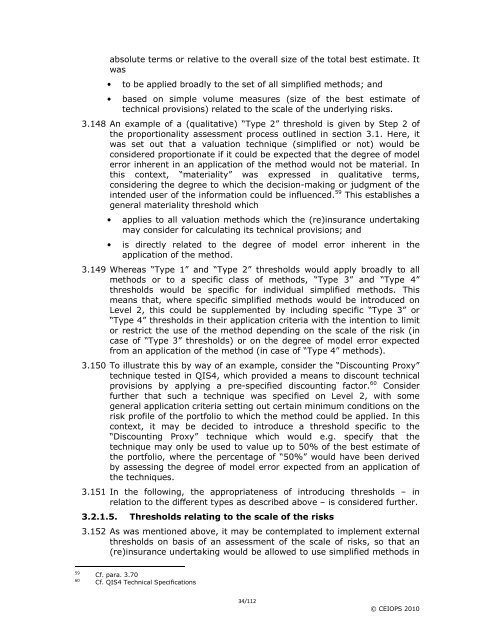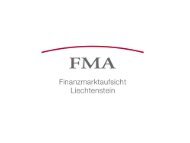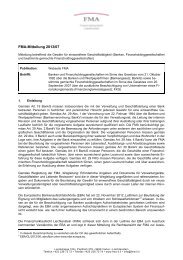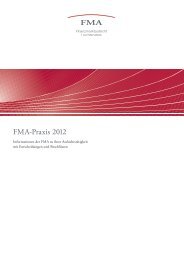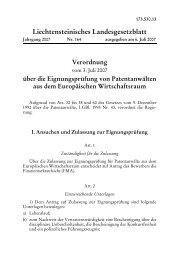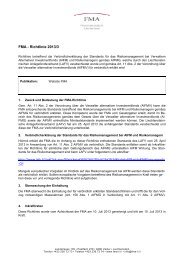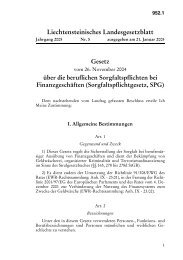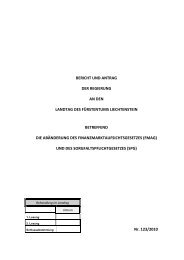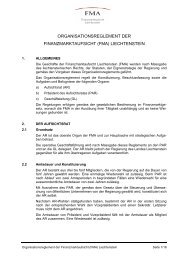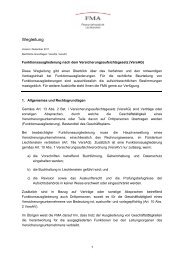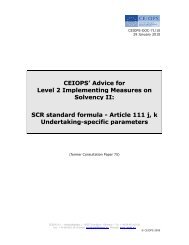CEIOPS' Advice for Level 2 Implementing ... - EIOPA - Europa
CEIOPS' Advice for Level 2 Implementing ... - EIOPA - Europa
CEIOPS' Advice for Level 2 Implementing ... - EIOPA - Europa
You also want an ePaper? Increase the reach of your titles
YUMPU automatically turns print PDFs into web optimized ePapers that Google loves.
absolute terms or relative to the overall size of the total best estimate. It<br />
was<br />
• to be applied broadly to the set of all simplified methods; and<br />
• based on simple volume measures (size of the best estimate of<br />
technical provisions) related to the scale of the underlying risks.<br />
3.148 An example of a (qualitative) “Type 2” threshold is given by Step 2 of<br />
the proportionality assessment process outlined in section 3.1. Here, it<br />
was set out that a valuation technique (simplified or not) would be<br />
considered proportionate if it could be expected that the degree of model<br />
error inherent in an application of the method would not be material. In<br />
this context, “materiality” was expressed in qualitative terms,<br />
considering the degree to which the decision-making or judgment of the<br />
intended user of the in<strong>for</strong>mation could be influenced. 59 This establishes a<br />
general materiality threshold which<br />
• applies to all valuation methods which the (re)insurance undertaking<br />
may consider <strong>for</strong> calculating its technical provisions; and<br />
• is directly related to the degree of model error inherent in the<br />
application of the method.<br />
3.149 Whereas “Type 1” and “Type 2” thresholds would apply broadly to all<br />
methods or to a specific class of methods, “Type 3” and “Type 4”<br />
thresholds would be specific <strong>for</strong> individual simplified methods. This<br />
means that, where specific simplified methods would be introduced on<br />
<strong>Level</strong> 2, this could be supplemented by including specific “Type 3” or<br />
“Type 4” thresholds in their application criteria with the intention to limit<br />
or restrict the use of the method depending on the scale of the risk (in<br />
case of “Type 3” thresholds) or on the degree of model error expected<br />
from an application of the method (in case of “Type 4” methods).<br />
3.150 To illustrate this by way of an example, consider the “Discounting Proxy”<br />
technique tested in QIS4, which provided a means to discount technical<br />
provisions by applying a pre-specified discounting factor. 60 Consider<br />
further that such a technique was specified on <strong>Level</strong> 2, with some<br />
general application criteria setting out certain minimum conditions on the<br />
risk profile of the portfolio to which the method could be applied. In this<br />
context, it may be decided to introduce a threshold specific to the<br />
“Discounting Proxy” technique which would e.g. specify that the<br />
technique may only be used to value up to 50% of the best estimate of<br />
the portfolio, where the percentage of “50%” would have been derived<br />
by assessing the degree of model error expected from an application of<br />
the techniques.<br />
3.151 In the following, the appropriateness of introducing thresholds – in<br />
relation to the different types as described above – is considered further.<br />
3.2.1.5. Thresholds relating to the scale of the risks<br />
3.152 As was mentioned above, it may be contemplated to implement external<br />
thresholds on basis of an assessment of the scale of risks, so that an<br />
(re)insurance undertaking would be allowed to use simplified methods in<br />
59 Cf. para. 3.70<br />
60 Cf. QIS4 Technical Specifications<br />
34/112<br />
© CEIOPS 2010


